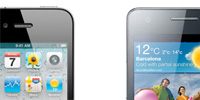I’ve stated before that I believe comparisons like this are unnecessary on mobile devices (for example, a faster processor on a phone doesn’t make a phone better if there are no apps that you use that can take advantage of it), however with recent comparisons I’ve noticed many problems. For one, the comparisons are often wrong (I’m looking at you, Engadget). Secondly, the categories are not equal. Winning in one category, say storage, and losing in another category, say sim standard, does not mean that two categories are equal. To me, storage might be important, to you it might not. However, sim standard is probably not important to anybody, so making it a category is tilting the scales in my opinion.
Then there are categories that are more about personal preference. Perhaps you enjoy Android more than iOS, perhaps you prefer a smaller screen to a bigger screen. Marking something as a ‘win’ because it has a bigger screen is not legitimate because this is subjective. Also, just because one category is a win and another may be a loss does not take into account the degree to which a category is a win or loss. If one category loses because it has 802.11b/g/n and the opposition has 802.11a/b/g/n, does 802.11a compatibility really constitute a win?
So, why worry about this at all? I believe that comparisons like these are meant to sway opinions rather than to inform individuals.
Each persons needs are different, so when you look at a comparison chart like this you should really take it with a grain of salt. Look at the features you want, look at how the OS works, go to the store and try out each phone, and make your own pros/cons list.
To that end, I’ve created a comparison table, for those who care about such things, with what I believe are the fairest categories for what are most likely the top two smartphones out there: the iPhone 4S and Galaxy S II. However, I encourage you to make your own list and try out each phone. Research the apps you want, see how certain apps work (such as email if you plan on using it a lot on your phone) and make your own matrix.
| iPhone 4S | Galaxy S II | |
|---|---|---|
| Platform | iOS 5 | Android 2.3.4 with TouchWiz 4.0 |
| Processor * | Dual-core Apple A5 1GHz Dual-graphics | 1.2GHz dual-core Samsung Exynos or 1.5GHz dual-core Qualcomm Snapdragon S3 |
| Storage | 16GB / 32GB / 64GB internal | 16GB / 32GB internal, microSDHC expansion |
| Cellular | Quadband GSM, quadband HSPA+ 14.4, CDMA / EDVO Rev. A | Quadband GSM, quadband HSPA+ 21 / 42 or CDMA / EV-DO Rev. A, WiMax |
| Wireless | 802.11b/g/n Bluetooth 4.0 | 802.11a/b/g/n Bluetooth 3.0 |
| Display size | 3.5 inches | 4.3 or 4.5 inches |
| Display | IPS 960 x 640 326 DPI | Super AMOLED Plus 800 x 480 207/217 DPI |
| Integrated TV-out | AirPlay Dock connector | MHL |
| Primary camera | 8 megapixel AF, f2.4 lens, BSI sensor, LED flash | 8 megapixel AF, LED flash |
| Secondary camera | VGA | 2 megapixel |
| Video recording | 1080p at 30fps | 1080p at 30fps |
| Video calling | Yes | Yes |
| Location / orientation sensors | AGPS, compass, accelerometer, gyroscope | AGPS, compass, accelerometer, gyroscope |
| Battery life | 8 hours on 3G, 14 hours on 2G 40 hours audio, 10 hours video | 7-8.7 hours on 3G 5 hours video |
| Weight & Dimensions | 140 grams / 4.9 oz. 115.2 x 58.6 x 9.3mm | 116 grams / 4.1 oz. to 130 grams / 4.6 oz. 125.3 mm x 66.1 mm x 9.91 mm to 129.8 x 69.6 x 9.65mm |
| Voice Technology ** | Siri | Google Voice |
* Based on benchmarks of the same processor in the iPad 2.
** Siri has yet to be widely used, however contains many more features than Andoid’s Google Voice.

